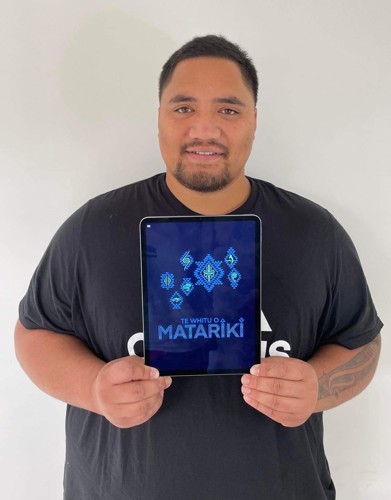Te Whitu o Matariki celebrated with unique design
8 Jun 2023, 3:32 PM

A time to rest, a time to reflect, and a time to prepare.
As the dawn rose on a new day today, it signalled the beginning of a tradition celebrated in Māori culture for centuries - Te Whitu o Matariki.
Te Whitu o Matariki – The Māori New Year – was traditionally observed as a time to rest, a time to acknowledge and a time to prepare for the seasons ahead. Nowadays, it is also a celebration of unity and is a time to gather and give thanks.
This year’s celebrations will be even more special with the development of newly designed flags to adorn the main streets in the Waitomo District. The flags will be raised on Rora Street in Te Kūiti on Monday 12 June at 7am.
Commissioned by Waitomo District Council with the support of Te Nehenehenui, the Matariki design is unique and specific to Ngāti Maniapoto.
Toi Māori artist Aihe Huirama Kete Takerei of Ngāti Maniapoto has drawn on local symbology, history and narrative to craft a visual representation of what Te Whitu o Matariki means to iwi and hapū throughout the rohe.
Each element and stroke incorporated into the design has a meaning and cultural significance.
“I’ve tried to keep the design as traditional as possible, while taking a more modern approach in how it is designed,” he said.
“It was really important to me that everything I added to the design was meaningful and had purpose.”
Matariki is the cluster of stars that appear in the heavens around the Winter solstice indicating the Māori New Year. There are many narratives of Matariki across many iwi, including the acknowledgement of nine stars.
The seven stars have been recognised for generations and is the most common narrative across many hapū, including Ngāti Maniapoto.
When drawing on inspiration for the design, Aihe said it was important to acknowledge Te Paki-o-Matariki, which is the coat of arms of the Kīngitanga movement and is carved on the door to the Māhinārangi meeting house at Tūrangawaewae marae in Ngāruawāhia.
“Te Paki-o-Matariki is a collection of information and narrative through visual design to illustrate the kaupapa of the Kīngitanga to the world. It was created as a symbol of peace, declaration of integrity and representation of unity for tangata whenua, all of which is grounded in the motto ‘Ko te Mana Motuhake’,” said Aihe.
“The intertwined koru pattern represents the creation of the world, the flow of time, and never-ending connection of the past, present and future. And in Te Ao Māori each of the stars of Matariki is associated with different domains of the environment and surroundings.”
It is this important kōrero that Aihe has based his design.
“The oldest star is Tupu-ā-rangi. She represents the eco-system of things that are up high and above the ground such as birds and fruits that hang on trees. Tupu-ā-rangi is represented by a Kererū.
“Tupu-ā-nuku is the star associated with everything that grows within the soil to be harvested or gathered for food including plants and animals. Tupu-ā-nuku is represented by a pikopiko.
“Waitī symbolises freshwater and is associated with all rivers, streams and lakes, and the food sources within them such as the eel.
“Waitā is saltwater and is associated with all the creatures that come from the ocean. It is represented by a kahawai.
“Waipuna-ā-rangi is connected with the atmosphere and represents clouds, rain and storms.
“The youngest star is Ururangi. In the Te Paki-o-Matariki story, it represents man and woman, but in other korero it represents rain. For this design I wanted to represent the intertwining of man and woman and the essence that lives within us.
“And lastly Matariki - I took more care with her because she is a mother. She is represented by a moko kauae which speaks to her authority and mana. It can also be referred to as Te Kauae Runga and Te Kauae Raro which refers to the heavens and earthly knowledge.”
Each star is also encompassed within a series of Niho Taniwha (triangle panel) shapes, which is a widely recognised symbol for Ngāti Maniapoto.
Tupu-ā-rangi is enveloped by a tree; Tupu-ā-nuku points to the ground; Waitī is surrounded by a fish pointing down; Waitā is surrounded by a fish pointing up; Waipuna-ā-rangi is the shape of a raindrop; Ururangi is the shape of intertwining koru and Matariki is a celestial body.
When all joined together, the design is a stunning illustration of tradition, culture and toi ātaahua.
“It has been a real honour to create this design for Te Whitu o Matariki and it just all came together well once I knew the kōrero I wanted to tell,” said Aihe.
His passion for art developed after spending years watching his whānau.
“I’ve always had a love of art and grew up around it.
“My late grandfather Charlie, had a passion for landscape art and my late uncle Te Kuiti Stewart was a master carver. I grew up watching them draw, carve and create beautiful works of art. My older brother Terirau is an artist so it was natural for me to follow in their footsteps.
Aihe is predominately interested in kōwhaiwhai and tā moko and has studied an art course through Wintec.
“I didn’t think of myself as much of an artist to begin with and I never put myself out there, but I have learnt to jump straight in, branch out and give things a go.
“I’m more of a traditional artist but digital art is where I am focused at the moment and I am enjoying being able to create works of art using technology.”
You can find examples of Aihe’s work on Facebook and Instagram under Toi Whenua.
